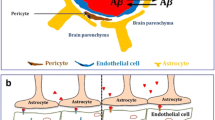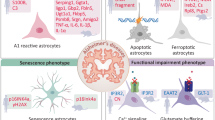Abstract
Astrocytes are a particular type of glial cells observed throughout the gray matter in the brain. In a healthy brain, they help to defend evolutionarily conserved astrogliosis programs and maintain neuronal metabolism. On the other hand, in the Alzheimer’s disease (AD) affected brain, they release neurotoxins because of the adopting behaviours of different functions depending on the disease progression. Along with astrocytes, amyloid-beta (A\(\beta \)) and tau proteins (\(\tau \)P) play a prominent role in AD. In this paper, we have developed a model and have studied the dual action of astrocytes with A\(\beta \), \(\tau \)P, and their toxic forms in the brain connectome. Initial conditions-dependent solutions of the model demonstrate that the treatment depends on AD’s status at the first diagnosis time. With an increase in the clearance rate of toxic A\(\beta \) by the astrocytes, the model predicts a cure possibility from AD. Furthermore, the network model with non-uniform parameter values in different regions, developed here, provides a better insight into the distributions of the concentrations in the brain connectome.
Access this chapter
Tax calculation will be finalised at checkout
Purchases are for personal use only
Similar content being viewed by others
References
Alzheimer’s Association: 2020 Alzheimer’s disease facts and figures. Alzheimer’s Dementia, pp. 391–460 (2020)
Vaz, M., Silvestre, S.: Alzheimer’s disease: recent treatment strategies. Eur. J. Pharmacol. 887, 173554 (2020)
Hardy, J.A., Higgins, G.A.: Alzheimer’s disease: the amyloid cascade hypothesis. Science 256, 184–186 (1992)
Götz, J., Halliday, G., Nisbet, R.M.: Molecular pathogenesis of the tauopathies. Annu. Rev. Pathol. 14, 239–261 (2019)
Verkhratsky, A., et al.: Astrocytes in Alzheimer’s disease. Neurother. Journal Am. Soc. Exp. Neurother. 7, 399–412 (2010)
Trujillo-Estrada, L., et al.: Astrocytes: from the physiology to the disease. Curr. Alzheimer Res. 16, 675–698 (2019)
Panatier, A., et al.: Glia-derived D-serine controls NMDA receptor activity and synaptic memory. Cell 125, 775–784 (2006)
Ding, S., et al.: Enhanced astrocytic Ca2+ signals contribute to neuronal excitotoxicity after status epilepticusm. J. Neurosci. 27, 10674–10684 (2007)
González-Reyes, R.E., et al.: Involvement of astrocytes in Alzheimer’s Disease from a neuroinflammatory and oxidative stress perspective. Front. Mol. Neurosci. 10, 427 (2017)
Rodríguez-Arellano, J.J., et al.: Astrocytes in physiological aging and Alzheimer’s disease. Neuroscience 323, 170–182 (2016)
Parameshwaran, K., Dhanasekaran, M., Suppiramaniam, V.: Amyloid beta peptides and glutamatergic synaptic dysregulation. Exp. Neurol. 210, 7–13 (2008)
Mota, S.I., Ferreira, I.L., Rego, A.C.: Dysfunctional synapse in Alzheimer’s disease - a focus on NMDA receptors. Neuropharmacology 76, 16–26 (2014)
Thompson, T.B., Chaggar, P., Kuhl, E., Goriely, A.: Protein-protein interactions in neurodegenerative diseases: a conspiracy theory. PLoS Comput. Biol. 16, e1008267 (2020)
Pal, S., Melnik, R.: Nonlocal models in the analysis of brain neurodegenerative protein dynamics with application to Alzheimer’s disease. Sci. Rep. 12, 7328 (2022)
Pal, S., Melnik, R.: Pathology dynamics in healthy-toxic protein interaction and the multiscale analysis of neurodegenerative diseases. In: Paszynski, M., Kranzlmüller, D., Krzhizhanovskaya, V.V., Dongarra, J.J., Sloot, P.M.A. (eds.) ICCS 2021. LNCS, vol. 12746, pp. 528–540. Springer, Cham (2021). https://doi.org/10.1007/978-3-030-77977-1_42
Pekny, M., Michael, N.: Astrocyte activation and reactive gliosis. Glia 50, 427–434 (2005)
Schäfer, A., et al.: Bayesian physics-based modeling of Tau propagation in Alzheimer’s Disease. Front. Physiol. 12, 702975 (2021)
Kerepesi, C., Szalkai, B., Varga, B., Grolmusz, V.: How to direct the edges of the connectomes: dynamics of the consensus connectomes and the development of the connections in the human brain. PLoS ONE 11, e0158680 (2016)
Ossenkoppele, R., Rabinovici, G.D., Smith, R., Miller, B.L.: Discriminative Accuracy of [18F] flortaucipir positron emission tomography for Alzheimer Disease vs other neurodegenerative disorders. JAMA 320, 1151–1162 (2018)
Acknowledgements
Authors are grateful to the NSERC and the CRC Program for their support. RM is also acknowledging support of the BERC 2022–2025 program and Spanish Ministry of Science, Innovation and Universities through the Agencia Estatal de Investigacion (AEI) BCAM Severo Ochoa excellence accreditation SEV-2017–0718 and the Basque Government fund AI in BCAM EXP. 2019/00432. This research was enabled in part by support provided by SHARCNET (www.sharcnet.ca) and Digital Research Alliance of Canada (www.alliancecan.ca).
Author information
Authors and Affiliations
Corresponding author
Editor information
Editors and Affiliations
Rights and permissions
Copyright information
© 2022 Springer Nature Switzerland AG
About this paper
Cite this paper
Pal, S., Melnik, R. (2022). The Role of Astrocytes in Alzheimer’s Disease Progression. In: Rojas, I., Valenzuela, O., Rojas, F., Herrera, L.J., Ortuño, F. (eds) Bioinformatics and Biomedical Engineering. IWBBIO 2022. Lecture Notes in Computer Science(), vol 13346. Springer, Cham. https://doi.org/10.1007/978-3-031-07704-3_5
Download citation
DOI: https://doi.org/10.1007/978-3-031-07704-3_5
Published:
Publisher Name: Springer, Cham
Print ISBN: 978-3-031-07703-6
Online ISBN: 978-3-031-07704-3
eBook Packages: Computer ScienceComputer Science (R0)




